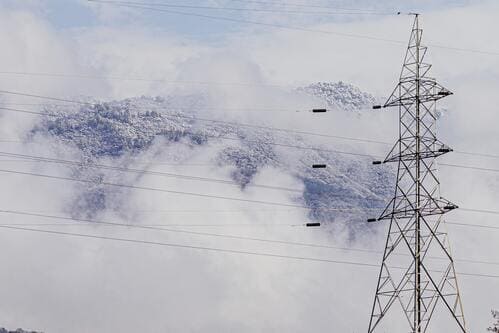Fiber Bragg grating sensors have a wide range of applications starting from the oil & gas industry and ending with structural health monitoring. However, few people know that FBG sensors are also effectively used to prevent icing on the overhead transmission lines.
According to the statistics, many countries have already faced great accidents and vast economic loss caused by the icing on the overhead transmission lines. The frequent icing load can lead to catastrophic consequences, for example, line breaks, short circuits, and tower collapses. In such disasters, thousands of people find themselves without electricity.

Fiber optic sensors VS electric ones in icing monitoring
Nowadays, there are different technologies for icing monitoring that can be produced both for individual transmission lines and for the whole energy transport infrastructure. The common ways of icing conditions estimation are dip-sag monitoring, video surveillance, non-contact infrared measurement, etc. All these methods usually can’t give accurate data on icing thickness, and they have got difficulties because of electromagnetic interference with the power supply.
Compared to the traditional sensors, fiber optic sensors improve the effectiveness of accident prevention through monitoring and control with the help of automated instruments and systems.
The main system’s features in icing monitoring are:
- The system monitors the onset of icing in accordance with changes in the load and sag of the span.
- The system includes an ice melting system.
- The system monitors the temperature of the ground wire and switches the melting off automatically.
FBG sensors’ main advantages for icing monitoring
In fact, fiber Bragg grating (FBG) sensors have already turned out to be an excellent solution for solving all the issues where electric sensors failed. In comparison with them, fiber optic sensors apply light for change monitoring in strain, temperature, and other parameters. It means that their accuracy doesn’t depend on electromagnetic interference.
Over recent years, FBG sensors have proved to have a lot of potential in monitoring the transmission lines. Fiber Bragg grating (FBG) sensors’ advantages are:
- compact size,
- lightweight,
- tolerance to corrosion and to electromagnetic interference,
- resistance to the environmental impact,
- high-temperature stability,
- explosion and fire safety,
- wide range of measurements, etc.
Scientists made FBG sensors able to define the accurate phase without a special reference point. Moreover, they can also suit for grid monitoring and distributed measurement.
Thanks to modern measurement methods such as distributed fiber optic sensors, a complex problem of monitoring the start of the ice formation can be solved, and there is the most effective way to eliminate it.
Optromix is a fast-growing vendor of fiber Bragg grating (FBG) product line such as fiber Bragg grating sensors, for example, fbg strain sensors, FBG interrogators and multiplexers, Distributed Acoustic Sensing (DAS) systems, Distributed Temperature Sensing (DTS) systems. The company creates and supplies a broad variety of fiber optic solutions for monitoring worldwide. If you are interested in structural health monitoring systems and want to learn more, please contact us at info@optromix.com

